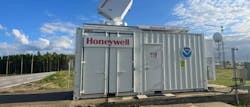NOAA taps Honeywell to deploy new weather observation technology
PHOENIX - Honeywell in Phoenix announced it has entered into a partnership with the National Oceanic and Atmospheric Administration’s (NOAA) National Weather Service (NWS) that will enable NOAA to research and evaluate how its upper air weather observation can be improved with the use of new technology from Honeywell.
Honeywell and NOAA signed a two-year Cooperative Research and Development Agreement (CRADA) to explore the utility and operational value of data from Honeywell’s High Altitude LiDAR Atmospheric Sensing (HALAS) system. HALAS is a remotely operated, ground-based weather information system that uses laser pulses to provide near real-time, high-altitude atmospheric data with more accuracy and spatial relevance than traditional weather balloons. With HALAS, NOAA will be able to collect measurements of the atmosphere at much faster intervals, enabling a better understanding of rapidly changing weather patterns and potentially leading to more accurate weather forecasting.
“Understanding the atmosphere above the surface is vital to predicting the evolution of weather phenomena, from local afternoon thunderstorms to expansive blizzards and hurricanes,” said Jordan Gerth, meteorologist, National Weather Service Office of Observations. “Through our partnership with Honeywell, this research project could help us identify a new way to gather the weather observations we need.”
HALAS enables forecasters to obtain weather data on wind speed and direction, humidity, temperature, and density from more than 100,000 feet above the surface of the Earth. NOAA meteorologists will now be able to access a new, location-specific atmospheric column of data that could offer new opportunities for understanding weather patterns and improving the prediction of existing weather models.
“NOAA is a world leader in weather forecasting, and we are proud to partner with the agency to lend our technology to enhance further their ability to observe and analyze near-real-time weather data,” said Matt Picchetti, vice president and general manager, Navigation and Sensors, Honeywell Aerospace Technologies. “From governments and militaries to businesses and individuals, there are countless stakeholders around the world who stand to benefit from the improved accuracy that HALAS can bring to weather predictions.”
As a result of the partnership, there is now a HALAS ground system located on the property of the National Weather Service Baltimore-Washington Weather Forecast Office in Sterling, Va. In the coming months, Honeywell technicians will also design a fixed HALAS installation prototype for NOAA that may be used to expand the deployment of HALAS at additional forecast offices across the U.S.
